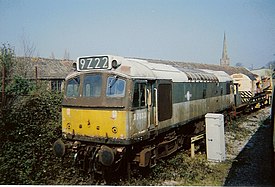BR Class 25 D7633
| BR Class 25 D7633 | |
|---|---|
 D7633 in 2007, after leaving the SVR | |
| Built By | Beyer Peacock |
| Configuration | Bo-Bo |
| Power type | Diesel electric |
| Status | Sold |
| Loco Number | D7633 |
| Other Numbers | 25283, 25904 |
| History | |
| Built | 1957 |
| Type | BR Class 25 |
| 1988 | Arrived on SVR |
| 2001 | Last worked |
| 2003 | Sold |
| Technical | |
| Length | 50ft 6in |
| Weight | 76 tons |
Contents
D7633 in Service
The locomotive was built by Beyer Peacock at Gorton, Manchester as Works No 8043 of 1965. It is a Type B Bo-Bo Diesel Electric locomotive, later designated Type 2 and BR Class 25. The type was used for a variety of duties from secondary passenger trains to shunting duties. Originally numbered D7633, it also carried the numbers 25283 from February 1974 and 25904 from November 1985.
D7633 was first allocated to Sheffield Tinsley but principally served with BR's London Midland Region, being allocated to the Liverpool, Birmingham and London Divisions and the Wigan Springs Branch before being withdrawn at Crewe in February 1987 with a turbocharger failure[1].
D7633 in Preservation
In 1986 the SVR’s P-Way Department began to look for a more powerful locomotive to replace the Ruston 0-4-0 shunters then in use, and established the SVR Permanent Way Diesel Locomotive Fund to raise money for that purpose.[2] 25904 was eventually selected, Gorton built locomotives having a reputation for good bodywork. It was acquired in late 1987,[3] and after asbestos removal at Leicester and tyre turning at Tyseley, it arrived on the SVR on 11 January 1988. It was repainted at Kidderminster in two-tone green livery as D7633 and after mechanical work at Bridgnorth, entered service the following month.[1]
As well as working engineers' trains, D7633 also featured regularly on diesel weekends and galas. However in late December 2000 it was 'red-carded' at Bridgnorth due to defective brakes and the electrical circuits being "quite literally, in a shocking state".[4] In October 2003 it was sold to D. Hurd / The Dean Forest Diesel Association and moved to the Dean Forest Railway for repair,[5] with Electro-Diesel E6005 (73005) arriving on loan to replace it.
See also
References
Links
British Rail Class 25 on Wikipedia
| ||||||||||||||||||||||||||||||||||||||||||||||||||||||||||||||||||||||||